What is Java?
Java is a programming language and a platform.
Java is a high level, robust, secured and object-oriented programming language.
Platform: Any hardware or software environment in which a program
runs, is known as a platform. Since Java has its own runtime environment
(JRE) and API, it is called platform.
Where it is used?
According to Sun, 3 billion devices run java. There are many devices where java is currently used. Some of them are as follows:
- Desktop Applications such as acrobat reader, media player, antivirus etc.
- Web Applications such as irctc.co.in, flipkart.com etc.
- Enterprise Applications such as banking applications.
- Mobile
- Embedded System
- Smart Card
- Robotics
- Games etc
Types of Java Applications
There are mainly 4 type of applications that can be created using java programming:
1) Standalone Application
It
is also known as desktop application or window-based application. An
application that we need to install on every machine such as media
player, antivirus etc. AWT and Swing are used in java for creating
standalone applications.
2) Web Application
An
application that runs on the server side and creates dynamic page, is
called web application. Currently, servlet, jsp, struts, jsf etc.
technologies are used for creating web applications in java.
3) Enterprise Application
An
application that is distributed in nature, such as banking applications
etc. It has the advantage of high level security, load balancing and
clustering. In java, EJB is used for creating enterprise applications.
4) Mobile Application
An application that is created for mobile devices. Currently Android and Java ME are used for creating mobile applications.
Java History
Java history is interesting to know. The history of java starts from Green Team. Java team members (also known as Green Team), initiated a revolutionary task to develop a language for digital devices such as set-top boxes, televisions etc.
For
the green team members, it was an advance concept at that time. But, it
was suited for internet programming. Later, Java technology as
incorporated by Netscape.
Currently,
Java is used in internet programming, mobile devices, games, e-business
solutions etc. There are given the major points that describes the
history of java.
1) James Gosling, Mike Sheridan, and Patrick Naughton initiated the Java language project in June 1991. The small team of sun engineers called Green Team.
2) Originally designed for small, embedded systems in electronic appliances like set-top boxes.
3) Firstly, it was called "Greentalk" by James Gosling and file extension was .gt.
4) After that, it was called Oak and was developed as a part of the Green project.
Why "Oak" name
5) Why Oak? Oak is a symbol of strength and choosen as a national tree of many countries like U.S.A., France, Germany, Romania etc.
6) In 1995, Oak was renamed as "Java" because it was already a trademark by Oak Technologies.
Why "Java" name
7) Why had they choosen java name for java language? The
team gathered to choose a new name. The suggested words were "dynamic",
"revolutionary", "Silk", "jolt", "DNA" etc. They wanted something that
reflected the essence of the technology: revolutionary, dynamic, lively,
cool, unique, and easy to spell and fun to say.
According to James Gosling "Java was one of the top choices along with Silk". Since java was so unique, most of the team members preferred java.
8) Java is an island of Indonesia where first coffee was produced (called java coffee).
9) Notice that Java is just a name not an acronym.
10)
Originally developed by James Gosling at Sun Microsystems (which is now a
subsidiary of Oracle Corporation) and released in 1995.
11) In 1995, Time magazine called Java one of the Ten Best Products of 1995.
12) JDK 1.0 released in(January 23, 1996).
Java Version History
There are many java versions that has been released. Current stable release of Java is Java SE 8.
- JDK Alpha and Beta (1995)
- JDK 1.0 (23rd Jan, 1996)
- JDK 1.1 (19th Feb, 1997)
- J2SE 1.2 (8th Dec, 1998)
- J2SE 1.3 (8th May, 2000)
- J2SE 1.4 (6th Feb, 2002)
- J2SE 5.0 (30th Sep, 2004)
- Java SE 6 (11th Dec, 2006)
- Java SE 7 (28th July, 2011)
- Java SE 8 (18th March, 2014)
11. Java SE 9 (September 21, 2017)
12. Java SE 10 (March 2018)
13.Java SE 11 (LTS) (September 2018)
14.
Java SE 12 (March 2019)
15. Java SE 13 (Early-Access Builds 31) (25 July 2019)
16.Java SE 14 (Early-Access Builds 7) (24 July 2019)
Features of Java
There
is given many features of java. They are also known as java buzzwords.
The Java Features given below are simple and easy to understand.
- Simple
- Object-Oriented
- Portable
- Platform independent
- Secured
- Robust
- Architecture neutral
- Dynamic
- Interpreted
- High Performance
- Multithreaded
- Distributed
Simple
According to Sun, Java language is simple because:
|
syntax is based on C++ (so easier for programmers to learn it after C++).
|
removed many confusing and/or rarely-used features e.g., explicit pointers, operator overloading etc.
|
No need to remove unreferenced objects because there is Automatic Garbage Collection in java.
|
Object-oriented
Object-oriented means we organize our software as a
combination of different types of objects that incorporates both data
and behaviour.
|
Object-oriented programming(OOPs) is a methodology that simplify software development and maintenance by providing some rules.
|
Basic concepts of OOPs are:
|
1. Object
2. Class
3. Inheritance
4. Polymorphism
5. Abstraction
6. Encapsulation
|
Platform Independent

A platform is the hardware or software environment in which a program runs.
There are two types of platforms software-based and hardware-based. Java provides software-based platform.
The
Java platform differs from most other platforms in the sense that it is
a software-based platform that runs on the top of other hardware-based
platforms. It has two components:
- Runtime Environment
- API(Application Programming Interface)
Java
code can be run on multiple platforms e.g. Windows, Linux, Sun Solaris,
Mac/OS etc. Java code is compiled by the compiler and converted into
bytecode. This bytecode is a platform-independent code because it can be
run on multiple platforms i.e. Write Once and Run Anywhere(WORA)
Secured
Java is secured because:
- No explicit pointer
- Java Programs run inside virtual machine sandbox

- Classloader: Classloader in Java is a part of the
Java Runtime Environment(JRE) which is used to load Java classes into
the Java Virtual Machine dynamically. It adds security by separating the
package for the classes of the local file system from those that are
imported from network sources.
- Bytecode Verifier: It checks the code fragments for illegal code that can violate access right to objects.
- Security Manager: It determines what resources a class can access such as reading and writing to the local disk.
Java language provides these securities by default. Some security can
also be provided by an application developer explicitly through SSL,
JAAS, Cryptography, etc.
Robust
Robust simply means strong. Java is robust because:
- It uses strong memory management.
- There is a lack of pointers that avoids security problems.
- There is automatic garbage collection in java which runs on the Java
Virtual Machine to get rid of objects which are not being used by a
Java application anymore.
- There are exception handling and the type checking mechanism in Java. All these points make Java robust.
Architecture-neutral
Java is architecture neutral because there are no implementation
dependent features, for example, the size of primitive types is fixed.
In C programming, int data type occupies 2 bytes of memory for 32-bit
architecture and 4 bytes of memory for 64-bit architecture. However, it
occupies 4 bytes of memory for both 32 and 64-bit architectures in
Java.
Portable
Java is portable because it facilitates you to carry the Java bytecode to any platform. It doesn't require any implementation.
High-performance
Java is faster than other traditional interpreted programming
languages because Java bytecode is "close" to native code. It is still a
little bit slower than a compiled language (e.g., C++). Java is an
interpreted language that is why it is slower than compiled languages,
e.g., C, C++, etc.
Distributed
Java is distributed because it facilitates users to create
distributed applications in Java. RMI and EJB are used for creating
distributed applications. This feature of Java makes us able to access
files by calling the methods from any machine on the internet.
Multi-threaded
A thread is like a separate program, executing concurrently. We can
write Java programs that deal with many tasks at once by defining
multiple threads. The main advantage of multi-threading is that it
doesn't occupy memory for each thread. It shares a common memory area.
Threads are important for multi-media, Web applications, etc.
Dynamic
Java is a dynamic language. It supports dynamic loading of classes.
It means classes are loaded on demand. It also supports functions from
its native languages, i.e., C and C++.
Java supports dynamic compilation and automatic memory management (garbage collection).
C++ vs Java
There are many differences and similarities between the C++ programming language and Java. A list of top differences between C++ and Java are given below:
| Comparison Index | C++ | Java |
|---|
| Platform-independent | C++ is platform-dependent. | Java is platform-independent. |
| Mainly used for | C++ is mainly used for system programming. | Java is mainly used for application programming. It is widely used in window, web-based, enterprise and mobile applications. |
| Design Goal | C++ was designed for systems and applications programming. It was an extension of C programming language. | Java
was designed and created as an interpreter for printing systems but
later extended as a support network computing. It was designed with a
goal of being easy to use and accessible to a broader audience.
|
| Goto | C++ supports the goto statement. | Java doesn't support the goto statement. |
| Multiple inheritance | C++ supports multiple inheritance. | Java doesn't support multiple inheritance through class. It can be achieved by interfaces in java. |
| Operator Overloading | C++ supports operator overloading. | Java doesn't support operator overloading. |
| Pointers | C++ supports pointers. You can write pointer program in C++. | Java
supports pointer internally. However, you can't write the pointer
program in java. It means java has restricted pointer support in java. |
| Compiler and Interpreter | C++ uses
compiler only. C++ is compiled and run using the compiler which converts
source code into machine code so, C++ is platform dependent.
| Java uses compiler and interpreter both. Java source code is
converted into bytecode at compilation time. The interpreter executes
this bytecode at runtime and produces output. Java is interpreted that
is why it is platform independent. |
| Call by Value and Call by reference | C++ supports both call by value and call by reference. | Java supports call by value only. There is no call by reference in java. |
| Structure and Union | C++ supports structures and unions. | Java doesn't support structures and unions. |
| Thread Support | C++ doesn't have built-in support for threads. It relies on third-party libraries for thread support. | Java has built-in thread support. |
| Documentation comment | C++ doesn't support documentation comment. | Java supports documentation comment (/** ... */) to create documentation for java source code. |
| Virtual Keyword | C++ supports virtual keyword so that we can decide whether or not override a function. | Java
has no virtual keyword. We can override all non-static methods by
default. In other words, non-static methods are virtual by default. |
| unsigned right shift >>> | C++ doesn't support >>> operator. | Java
supports unsigned right shift >>> operator that fills zero at
the top for the negative numbers. For positive numbers, it works same
like >> operator. |
| Inheritance Tree | C++ creates a new inheritance tree always. | Java
uses a single inheritance tree always because all classes are the child
of Object class in java. The object class is the root of the inheritance tree in java. |
| Hardware | C++ is nearer to hardware. | Java is not so interactive with hardware. |
| Object-oriented | C++ is an object-oriented language. However, in C language, single root hierarchy is not possible. | Java is also an object-oriented
language. However, everything (except fundamental types) is an object
in Java. It is a single root hierarchy as everything gets derived from
java.lang.Object.
|
Note
- Java doesn't support default arguments like C++.
- Java does not support header files like C++. Java uses the import keyword to include different classes and methods.
C++ Example
File: main.cpp
- #include <iostream>
- using namespace std;
- int main() {
- cout << "Hello C++ Programming";
- return 0;
- }
Java Example
File: Simple.java
- class Simple{
- public static void main(String args[]){
- System.out.println("Hello Java");
- }
- }
-
Compilation Flow:
When we compile Java program using javac tool, java compiler converts the source code into byte code.

| To compile: | javac Simple.java |
| To execute: | java Simple |
Understanding first java program
Let's see what is the meaning of class, public, static, void, main, String[], System.out.println().
- class keyword is used to declare a class in java.
- public keyword is an access modifier which represents visibility. It means it is visible to all.
- static is a keyword. If we declare any method as
static, it is known as the static method. The core advantage of the
static method is that there is no need to create an object to invoke the
static method. The main method is executed by the JVM, so it doesn't
require to create an object to invoke the main method. So it saves
memory.
- void is the return type of the method. It means it doesn't return any value.
- main represents the starting point of the program.
- String[] args is used for command line argument. We will learn it later.
- System.out.println() is used to print statement.
Here, System is a class, out is the object of PrintStream class,
println() is the method of PrintStream class. We will learn about the
internal working of System.out.println statement later.
How many ways can we write a Java program
There are many ways to write a Java program. The modifications that can be done in a Java program are given below:
1) By changing the sequence of the modifiers, method prototype is not changed in Java.
Let's see the simple code of the main method.
- static public void main(String args[])
2) The subscript notation in Java array can be used after type, before the variable or after the variable.
Let's see the different codes to write the main method.
- public static void main(String[] args)
- public static void main(String []args)
- public static void main(String args[])
3) You can provide var-args support to the main method by passing 3 ellipses (dots)
Let's see the simple code of using var-args in the main method. We will learn about var-args later in Java New Features chapter.
- public static void main(String... args)
4) Having a semicolon at the end of class is optional in Java.
Let's see the simple code.
- class A{
- static public void main(String... args){
- System.out.println("hello java4");
- }
- };
Valid java main method signature
- public static void main(String[] args)
- public static void main(String []args)
- public static void main(String args[])
- public static void main(String... args)
- static public void main(String[] args)
- public static final void main(String[] args)
- final public static void main(String[] args)
- final strictfp public static void main(String[] args)
Invalid java main method signature
- public void main(String[] args)
- static void main(String[] args)
- public void static main(String[] args)
- abstract public static void main(String[] args)
What happens at compile time?
At compile time, java file is compiled by Java Compiler (It does not interact with OS) and converts the java code into bytecode.

What happens at runtime?
At runtime, following steps are performed:
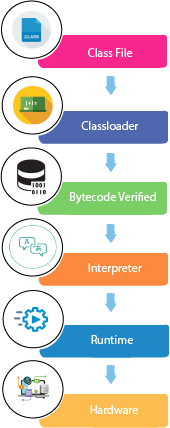
| Classloader: is the subsystem of JVM that is used to load class files. |
| Bytecode Verifier: checks the code fragments for illegal code that can violate access right to objects. |
| Interpreter: read bytecode stream then execute the instructions. |
Q) Can you save a java source file by other name than the class name?
| Yes, if the class is not public. It is explained in the figure given below: |
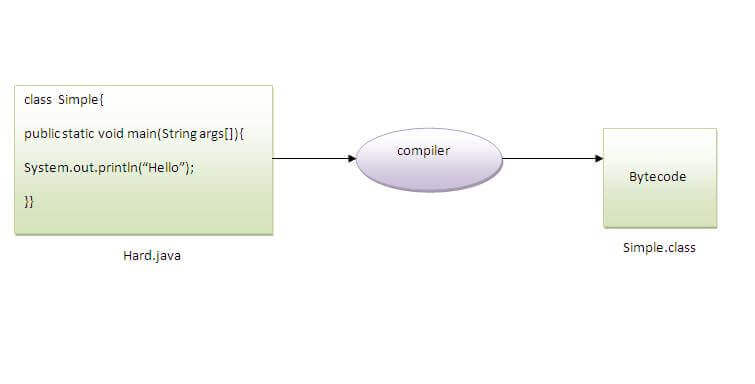 |
| To compile: | javac Hard.java |
| To execute: | java Simple |
Can you have multiple classes in a java source file?
| Yes, like the figure given below illustrates: |

|
Difference between JDK, JRE, and JVM
JVM
JVM (Java Virtual Machine) is an abstract machine. It is called a
virtual machine because it doesn't physically exist. It is a
specification that provides a runtime environment in which Java bytecode
can be executed. It can also run those programs which are written in
other languages and compiled to Java bytecode.
JVMs are available for many hardware and software platforms. JVM,
JRE, and JDK are platform dependent because the configuration of each OS is different from each other. However, Java is platform independent. There are three notions of the JVM: specification, implementation, and instance.
The JVM performs the following main tasks:
- Loads code
- Verifies code
- Executes code
- Provides runtime environment
JRE
JRE is an acronym for Java Runtime Environment. It is also written as
Java RTE. The Java Runtime Environment is a set of software tools which
are used for developing Java applications. It is used to provide the
runtime environment. It is the implementation of JVM. It physically
exists. It contains a set of libraries + other files that JVM uses at
runtime.
The implementation of JVM is also actively released by other companies besides Sun Micro Systems.
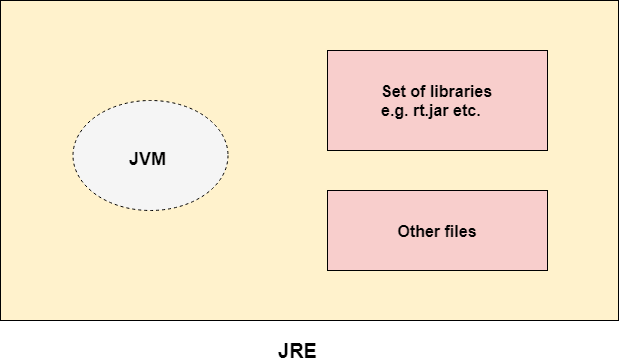
JDK
JDK is an acronym for Java Development Kit. The Java Development Kit
(JDK) is a software development environment which is used to develop
Java applications and applets. It physically exists. It contains JRE + development tools.
JDK is an implementation of any one of the below given Java Platforms released by Oracle Corporation:
- Standard Edition Java Platform
- Enterprise Edition Java Platform
- Micro Edition Java Platform
The JDK contains a private Java Virtual Machine (JVM) and a few other
resources such as an interpreter/loader (java), a compiler (javac), an
archiver (jar), a documentation generator (Javadoc), etc. to complete
the development of a Java Application.
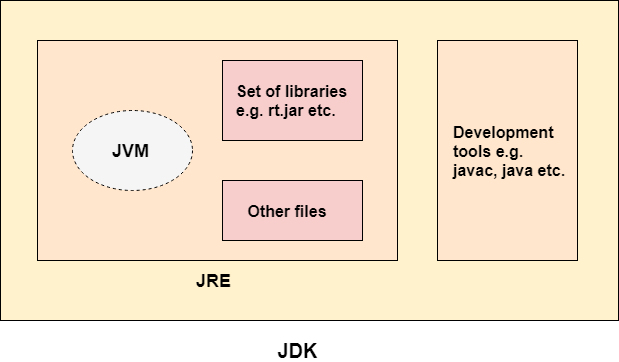 |
| | | |
|
|
Components of JDK
Following is a list of primary components of JDK:
| appletviewer: |
This tool is used to run and debug Java applets without a web browser. |
| apt: |
It is an annotation-processing tool. |
| extcheck: |
it is a utility that detects JAR file conflicts. |
| idlj: |
An IDL-to-Java compiler. This utility generates Java bindings from a given Java IDL file. |
| jabswitch: |
It is a Java Access Bridge. Exposes assistive technologies on Microsoft Windows systems. |
| java: |
The loader for Java applications. This tool is an interpreter and
can interpret the class files generated by the javac compiler. Now a
single launcher is used for both development and deployment. The old
deployment launcher, jre, no longer comes with Sun JDK, and instead it
has been replaced by this new java loader. |
| javac: |
It specifies the Java compiler, which converts source code into Java bytecode. |
| javadoc: |
The documentation generator, which automatically generates documentation from source code comments |
| jar: |
The specifies the archiver, which packages related class libraries
into a single JAR file. This tool also helps manage JAR files. |
| javafxpackager: |
It is a tool to package and sign JavaFX applications. |
| jarsigner: |
the jar signing and verification tool. |
| javah: |
the C header and stub generator, used to write native methods. |
| javap: |
the class file disassembler. |
| javaws: |
the Java Web Start launcher for JNLP applications. |
| JConsole: |
Java Monitoring and Management Console. |
| jdb: |
the debugger. |
| jhat: |
Java Heap Analysis Tool (experimental). |
| jinfo: |
This utility gets configuration information from a running Java process or crash dump. |
| jmap: |
Oracle jmap - Memory Map- This utility outputs the memory map for
Java and can print shared object memory maps or heap memory details of a
given process or core dump. |
| jmc: |
Java Mission Control |
| jps: |
Java Virtual Machine Process Status Tool lists the instrumented HotSpot Java Virtual Machines (JVMs) on the target system. |
| jrunscript: |
Java command-line script shell. |
| jstack: |
It is a utility that prints Java stack traces of Java threads (experimental). |
| jstat: |
Java Virtual Machine statistics monitoring tool (experimental). |
| jstatd: |
jstat daemon (experimental). |
| keytool: |
It is a tool for manipulating the keystore. |
| pack200: |
JAR compression tool. |
| Policytool: |
It specifies the policy creation and management tool, which can
determine policy for a Java runtime, specifying which permissions are
available for code from various sources. |
| VisualVM: |
It is a visual tool integrating several command-line JDK tools and
lightweight [clarification needed] performance and memory profiling
capabilities |
| wsimport: |
It generates portable JAX-WS artifacts for invoking a web service. |
| xjc: |
It is the part of the Java API for XML Binding (JAXB) API. It accepts an XML schema and generates Java classes. |
JVM (Java Virtual Machine) Architecture
JVM (Java Virtual Machine) is an abstract machine. It is a
specification that provides runtime environment in which java bytecode
can be executed.
JVMs are available for many hardware and software platforms (i.e. JVM is platform dependent).
What is JVM
It is:
- A specification where working of Java Virtual Machine is
specified. But implementation provider is independent to choose the
algorithm. Its implementation has been provided by Oracle and other
companies.
- An implementation Its implementation is known as JRE (Java Runtime Environment).
- Runtime Instance Whenever you write java command on the command prompt to run the java class, an instance of JVM is created.
What it does
The JVM performs following operation:
- Loads code
- Verifies code
- Executes code
- Provides runtime environment
JVM provides definitions for the:
- Memory area
- Class file format
- Register set
- Garbage-collected heap
- Fatal error reporting etc.
JVM Architecture
Let's understand the internal architecture of JVM. It contains classloader, memory area, execution engine etc.
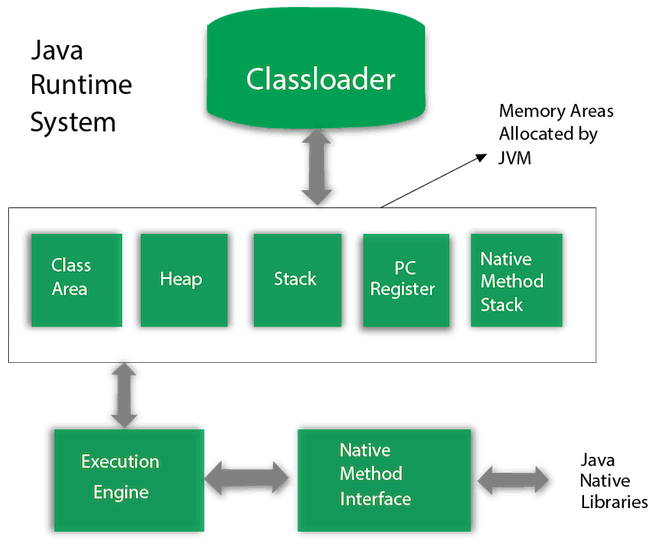
1) Classloader
Classloader is a subsystem of JVM which is used to load class files.
Whenever we run the java program, it is loaded first by the classloader.
There are three built-in classloaders in Java.
- Bootstrap ClassLoader: This is the first classloader which is the super class of Extension classloader. It loads the rt.jar
file which contains all class files of Java Standard Edition like
java.lang package classes, java.net package classes, java.util package
classes, java.io package classes, java.sql package classes etc.
- Extension ClassLoader: This is the child
classloader of Bootstrap and parent classloader of System classloader.
It loades the jar files located inside $JAVA_HOME/jre/lib/ext directory.
- System/Application ClassLoader: This is the
child classloader of Extension classloader. It loads the classfiles from
classpath. By default, classpath is set to current directory. You can
change the classpath using "-cp" or "-classpath" switch. It is also
known as Application classloader.
-
- public class ClassLoaderExample
- {
- public static void main(String[] args)
- {
-
-
- Class c=ClassLoaderExample.class;
- System.out.println(c.getClassLoader());
-
-
- System.out.println(String.class.getClassLoader());
- }
- }
Output:
sun.misc.Launcher$AppClassLoader@4e0e2f2a
null
These are the internal classloaders provided by Java. If you want to
create your own classloader, you need to extend the ClassLoader class.
2) Class(Method) Area
Class(Method) Area stores per-class structures such as the runtime constant pool, field and method data, the code for methods.
3) Heap
It is the runtime data area in which objects are allocated.
4) Stack
Java Stack stores frames. It holds local variables and partial results, and plays a part in method invocation and return.
Each thread has a private JVM stack, created at the same time as thread.
A new frame is created each time a method is invoked. A frame is destroyed when its method invocation completes.
5) Program Counter Register
PC (program counter) register contains the address of the Java virtual machine instruction currently being executed.
6) Native Method Stack
It contains all the native methods used in the application.
7) Execution Engine
It contains:
- A virtual processor
- Interpreter: Read bytecode stream then execute the instructions.
- Just-In-Time(JIT) compiler: It is used to improve
the performance. JIT compiles parts of the byte code that have similar
functionality at the same time, and hence reduces the amount of time
needed for compilation. Here, the term "compiler" refers to a translator
from the instruction set of a Java virtual machine (JVM) to the
instruction set of a specific CPU.
8) Java Native Interface
Java Native Interface (JNI) is a framework which provides an
interface to communicate with another application written in another
language like C, C++, Assembly etc. Java uses JNI framework to send
output to the Console or interact with OS libraries.
Java Variables
A variable is a container which holds the value while the java program is executed. A variable is assigned with a datatype.
Variable is a name of memory location. There are three types of variables in java: local, instance and static.
There are two types of data types in java: primitive and non-primitive.
Variable
Variable is name of reserved area allocated in memory. In other words, it is a name of memory location. It is a combination of "vary + able" that means its value can be changed.
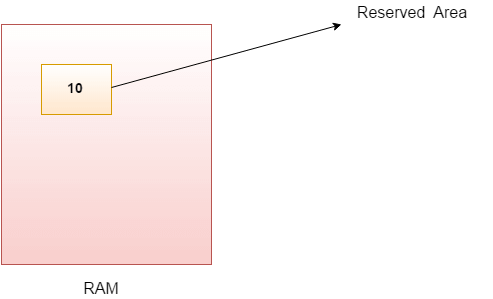
Types of Variables
There are three types of variables in java:
- local variable
- instance variable
- static variable
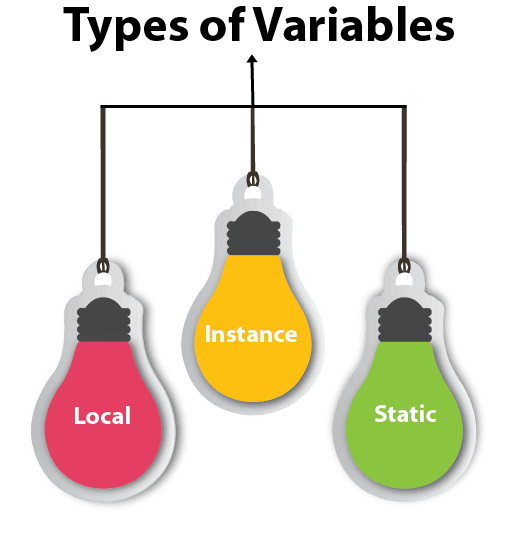
1) Local Variable
A variable declared inside the body of the method is called local
variable. You can use this variable only within that method and the
other methods in the class aren't even aware that the variable exists.
A local variable cannot be defined with "static" keyword.
2) Instance Variable
A variable declared inside the class but outside the body of the
method, is called instance variable. It is not declared as static.
It is called instance variable because its value is instance specific and is not shared among instances.
3) Static variable
A variable which is declared as static is called static variable. It
cannot be local. You can create a single copy of static variable and
share among all the instances of the class. Memory allocation for static
variable happens only once when the class is loaded in the memory.
Example to understand the types of variables in java
- class A{
- int data=50;
- static int m=100;
- void method(){
- int n=90;
- }
- }
Java Variable Example: Add Two Numbers
- class Simple{
- public static void main(String[] args){
- int a=10;
- int b=10;
- int c=a+b;
- System.out.println(c);
- }}
Output:
Java Variable Example: Widening
- class Simple{
- public static void main(String[] args){
- int a=10;
- float f=a;
- System.out.println(a);
- System.out.println(f);
- }}
Output:
Java Variable Example: Narrowing (Typecasting)
- class Simple{
- public static void main(String[] args){
- float f=10.5f;
-
- int a=(int)f;
- System.out.println(f);
- System.out.println(a);
- }}
Output:
Java Variable Example: Overflow
- class Simple{
- public static void main(String[] args){
-
- int a=130;
- byte b=(byte)a;
- System.out.println(a);
- System.out.println(b);
- }}
Output:
Java Variable Example: Adding Lower Type
- class Simple{
- public static void main(String[] args){
- byte a=10;
- byte b=10;
-
- byte c=(byte)(a+b);
- System.out.println(c);
- }}
Output:
20
Data Types in Java
Data types specify the different sizes and values that can be stored
in the variable. There are two types of data types in Java:
- Primitive data types: The primitive data types include boolean, char, byte, short, int, long, float and double.
- Non-primitive data types: The non-primitive data types include Classes, Interfaces, and Arrays.
Java Primitive Data Types
In Java language, primitive data types are the building blocks of
data manipulation. These are the most basic data types available in Java
language.
Java is a statically-typed programming language. It means,
all variables must be declared before its use. That is why we need to
declare variable's type and name.
There are 8 types of primitive data types:
- boolean data type
- byte data type
- char data type
- short data type
- int data type
- long data type
- float data type
- double data type

| Data Type |
Default Value |
Default size |
| boolean |
false |
1 bit |
| char |
'\u0000' |
2 byte |
| byte |
0 |
1 byte |
| short |
0 |
2 byte |
| int |
0 |
4 byte |
| long |
0L |
8 byte |
| float |
0.0f |
4 byte |
| double |
0.0d |
8 byte |
Boolean Data Type
The Boolean data type is used to store only two possible values: true
and false. This data type is used for simple flags that track
true/false conditions.
The Boolean data type specifies one bit of information, but its "size" can't be defined precisely.
Example: Boolean one = false
Byte Data Type
The byte data type is an example of primitive data type. It isan
8-bit signed two's complement integer. Its value-range lies between -128
to 127 (inclusive). Its minimum value is -128 and maximum value is 127.
Its default value is 0.
The byte data type is used to save memory in large arrays where the
memory savings is most required. It saves space because a byte is 4
times smaller than an integer. It can also be used in place of "int"
data type.
Example: byte a = 10, byte b = -20
Short Data Type
The short data type is a 16-bit signed two's complement integer. Its
value-range lies between -32,768 to 32,767 (inclusive). Its minimum
value is -32,768 and maximum value is 32,767. Its default value is 0.
The short data type can also be used to save memory just like byte
data type. A short data type is 2 times smaller than an integer.
Example: short s = 10000, short r = -5000
Int Data Type
The int data type is a 32-bit signed two's complement integer. Its
value-range lies between - 2,147,483,648 (-2^31) to 2,147,483,647 (2^31
-1) (inclusive). Its minimum value is - 2,147,483,648and maximum value
is 2,147,483,647. Its default value is 0.
The int data type is generally used as a default data type for integral values unless if there is no problem about memory.
Example: int a = 100000, int b = -200000
Long Data Type
The long data type is a 64-bit two's complement integer. Its
value-range lies between -9,223,372,036,854,775,808(-2^63) to
9,223,372,036,854,775,807(2^63 -1)(inclusive). Its minimum value is -
9,223,372,036,854,775,808and maximum value is 9,223,372,036,854,775,807.
Its default value is 0. The long data type is used when you need a
range of values more than those provided by int.
Example: long a = 100000L, long b = -200000L
Float Data Type
The float data type is a single-precision 32-bit IEEE 754 floating
point.Its value range is unlimited. It is recommended to use a float
(instead of double) if you need to save memory in large arrays of
floating point numbers. The float data type should never be used for
precise values, such as currency. Its default value is 0.0F.
Example: float f1 = 234.5f
Double Data Type
The double data type is a double-precision 64-bit IEEE 754 floating
point. Its value range is unlimited. The double data type is generally
used for decimal values just like float. The double data type also
should never be used for precise values, such as currency. Its default
value is 0.0d.
Example: double d1 = 12.3
Char Data Type
The char data type is a single 16-bit Unicode character. Its
value-range lies between '\u0000' (or 0) to '\uffff' (or 65,535
inclusive).The char data type is used to store characters.
Example: char letterA = 'A'
Why char uses 2 byte in java and what is \u0000 ?
It is because java uses Unicode system not ASCII code system. The
\u0000 is the lowest range of Unicode system. To get detail explanation
about Unicode visit next page.
Unicode System
| Unicode is a universal international standard character
encoding that is capable of representing most of the world's written
languages. |
Why java uses Unicode System?
| Before Unicode, there were many language standards: |
- ASCII (American Standard Code for Information Interchange) for the United States.
- ISO 8859-1 for Western European Language.
- KOI-8 for Russian.
- GB18030 and BIG-5 for chinese, and so on.
|
Problem
This caused two problems:
- A particular code value corresponds to different letters in the various language standards.
- The encodings for languages with large character sets have variable
length.Some common characters are encoded as single bytes, other require
two or more byte.
|
Solution
| To solve these problems, a new language standard was developed i.e. Unicode System. |
| In unicode, character holds 2 byte, so java also uses 2 byte for characters. |
| lowest value:\u0000 |
highest value:\uFFFF
Operators in java
Operator in java is a symbol that is used to perform operations. For example: +, -, *, / etc.
There are many types of operators in java which are given below:
- Unary Operator,
- Arithmetic Operator,
- Shift Operator,
- Relational Operator,
- Bitwise Operator,
- Logical Operator,
- Ternary Operator and
- Assignment Operator.
Java Operator Precedence
| Operator Type | Category | Precedence |
|---|
| Unary | postfix | expr++ expr-- |
| prefix | ++expr --expr +expr -expr ~ ! |
| Arithmetic | multiplicative | * / % |
| additive | + - |
| Shift | shift | << >> >>> |
| Relational | comparison | < > <= >= instanceof |
| equality | == != |
| Bitwise | bitwise AND | & |
| bitwise exclusive OR | ^ |
| bitwise inclusive OR | | |
| Logical | logical AND | && |
| logical OR | || |
| Ternary | ternary | ? : |
| Assignment | assignment | = += -= *= /= %= &= ^= |= <<= >>= >>>= |
Java Unary Operator
The Java unary operators require only one operand. Unary operators are used to perform various operations i.e.:
- incrementing/decrementing a value by one
- negating an expression
- inverting the value of a boolean
Java Unary Operator Example: ++ and --
- class OperatorExample{
- public static void main(String args[]){
- int x=10;
- System.out.println(x++);
- System.out.println(++x);
- System.out.println(x--);
- System.out.println(--x);
- }}
Output:
Java Unary Operator Example 2: ++ and --
- class OperatorExample{
- public static void main(String args[]){
- int a=10;
- int b=10;
- System.out.println(a++ + ++a);
- System.out.println(b++ + b++);
-
- }}
Output:
Java Unary Operator Example: ~ and !
- class OperatorExample{
- public static void main(String args[]){
- int a=10;
- int b=-10;
- boolean c=true;
- boolean d=false;
- System.out.println(~a);
- System.out.println(~b);
- System.out.println(!c);
- System.out.println(!d);
- }}
Output:
Java Arithmetic Operators
Java arithmatic operators are used to perform addition, subtraction,
multiplication, and division. They act as basic mathematical operations.
Java Arithmetic Operator Example
- class OperatorExample{
- public static void main(String args[]){
- int a=10;
- int b=5;
- System.out.println(a+b);
- System.out.println(a-b);
- System.out.println(a*b);
- System.out.println(a/b);
- System.out.println(a%b);
- }}
Output:
Java Arithmetic Operator Example: Expression
- class OperatorExample{
- public static void main(String args[]){
- System.out.println(10*10/5+3-1*4/2);
- }}
Output:
Java Left Shift Operator
The Java left shift operator << is used to shift all of the
bits in a value to the left side of a specified number of times.
Java Left Shift Operator Example
- class OperatorExample{
- public static void main(String args[]){
- System.out.println(10<<2);
- System.out.println(10<<3);
- System.out.println(20<<2);
- System.out.println(15<<4);
- }}
Output:
Java Right Shift Operator
The Java right shift operator >> is used to move left operands
value to right by the number of bits specified by the right operand.
Java Right Shift Operator Example
- class OperatorExample{
- public static void main(String args[]){
- System.out.println(10>>2);
- System.out.println(20>>2);
- System.out.println(20>>3);
- }}
Output:
Java Shift Operator Example: >> vs >>>
- class OperatorExample{
- public static void main(String args[]){
-
- System.out.println(20>>2);
- System.out.println(20>>>2);
-
- System.out.println(-20>>2);
- System.out.println(-20>>>2);
- }}
Output:
Java AND Operator Example: Logical && and Bitwise &
The logical && operator doesn't check second condition if
first condition is false. It checks second condition only if first one
is true.
The bitwise & operator always checks both conditions whether first condition is true or false.
- class OperatorExample{
- public static void main(String args[]){
- int a=10;
- int b=5;
- int c=20;
- System.out.println(a<b&&a<c);
- System.out.println(a<b&a<c);
- }}
Output:
Java AND Operator Example: Logical && vs Bitwise &
- class OperatorExample{
- public static void main(String args[]){
- int a=10;
- int b=5;
- int c=20;
- System.out.println(a<b&&a++<c);
- System.out.println(a);
- System.out.println(a<b&a++<c);
- System.out.println(a);
- }}
Output:
Java OR Operator Example: Logical || and Bitwise |
The logical || operator doesn't check second condition if first
condition is true. It checks second condition only if first one is
false.
The bitwise | operator always checks both conditions whether first condition is true or false.
- class OperatorExample{
- public static void main(String args[]){
- int a=10;
- int b=5;
- int c=20;
- System.out.println(a>b||a<c);
- System.out.println(a>b|a<c);
-
- System.out.println(a>b||a++<c);
- System.out.println(a);
- System.out.println(a>b|a++<c);
- System.out.println(a);
- }}
Output:
true
true
true
10
true
11
Java Ternary Operator
Java Ternary operator is used as one liner replacement for
if-then-else statement and used a lot in java programming. it is the
only conditional operator which takes three operands.
Java Ternary Operator Example
- class OperatorExample{
- public static void main(String args[]){
- int a=2;
- int b=5;
- int min=(a<b)?a:b;
- System.out.println(min);
- }}
Output:
Another Example:
- class OperatorExample{
- public static void main(String args[]){
- int a=10;
- int b=5;
- int min=(a<b)?a:b;
- System.out.println(min);
- }}
Output:
Java Assignment Operator
Java assignment operator is one of the most common operator. It is used to
assign the value on its right to the operand on its left.
Java Assignment Operator Example
- class OperatorExample{
- public static void main(String args[]){
- int a=10;
- int b=20;
- a+=4;
- b-=4;
- System.out.println(a);
- System.out.println(b);
- }}
Output:
Java Assignment Operator Example
- class OperatorExample{
- public static void main(String[] args){
- int a=10;
- a+=3;
- System.out.println(a);
- a-=4;
- System.out.println(a);
- a*=2;
- System.out.println(a);
- a/=2;
- System.out.println(a);
- }}
Output:
Java Assignment Operator Example: Adding short
- class OperatorExample{
- public static void main(String args[]){
- short a=10;
- short b=10;
-
- a=a+b;
- System.out.println(a);
- }}
Output:
After type cast:
- class OperatorExample{
- public static void main(String args[]){
- short a=10;
- short b=10;
- a=(short)(a+b);
- System.out.println(a);
- }}
Output:
| | | | | | |
|
| | | | | | | | | | | | | | |
|


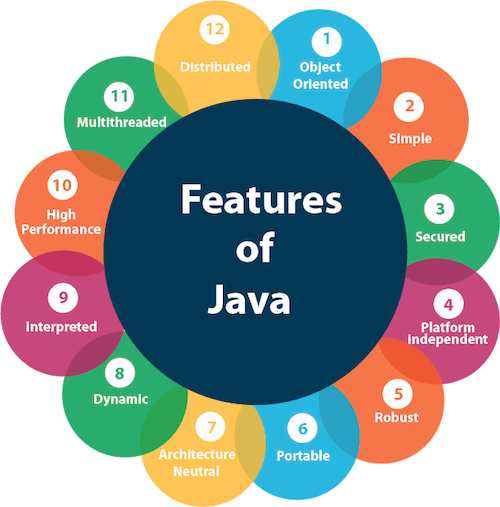













No comments:
Post a Comment